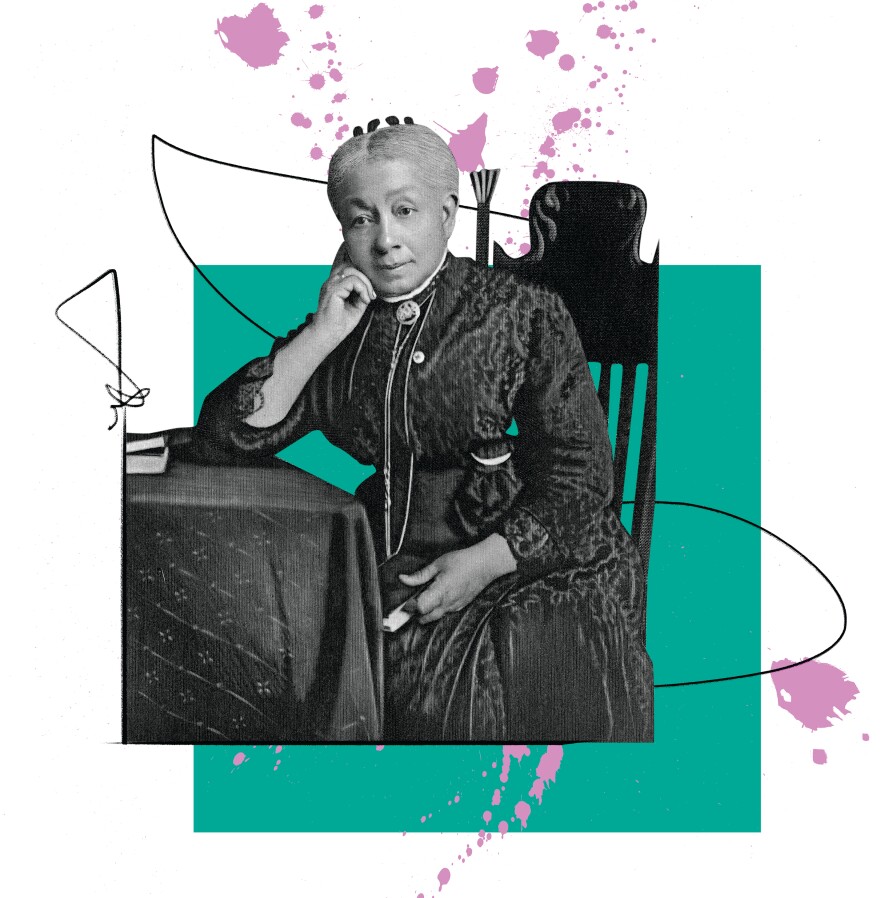David Seitz | Community Voices
This summer, we have seen both the 100th anniversary of women’s right to vote and the surge of Black Lives Matter protests. Now, The National Afro-American Museum & Cultural Center in Wilberforce, Ohio brings us, Queens of the Heartland. This exhibit tells the stories of 30 African American women in Ohio from the 1830s to today. You may know some of these women like Ruby Dee and Toni Morrison, but other may be less familiar.
When you walk into the exhibit, you’re surrounded by historic photos of black women. Artist Nichole Washington was inspired by these photos.
“Photography is so magical,” she says, “It’s not only like you’re recording just what the person looks like, but I feel like it’s almost like you’re capturing a bit of their spirit. “
Washington did that by splashing the photos with colors, shapes, and curved lines.
Museum curator Hadley Drodge collaborated with Washington on the show. As curator, Drodge researched and gathered the women’s stories. And one story she loves to tell is of Susan Maria Steward. After the civil war, Susan Steward became of the first black doctors in the country.
“She was largely inspired to become a physician after taking care of a family member through the cholera epidemic,” Drodge explains. “And so she followed her husband to Fort Missoula, Montana to care for the 25th US Colored infantry and people in that community and became a physician to the Buffalo soldiers there.”
Doctor Steward later taught at Wilberforce College for many years and fought for better public health throughout her life. Drodge says that Steward delivered papers at international conferences on black women’s health. “We’re at a crossroads right now,” says Drodge, “where we’re pushing to have racism be considered a national public health crisis, and I think she knew it was.”
At Wilberforce, Steward met Hallie Quinn Brown, by then a renowned teacher of public speaking and a fiery activist for women and black causes. Hallie’s parents were former slaves who ran a stop on the Underground Railroad in Pittsburgh. They moved to Canada, where Hallie resisted racism in the classroom where black children had to sit in the back and were never called upon.
Drodge tells this story, "And so Hallie, this little girl, tears the teacher’s skirt and throws a book at her and runs out of the classroom because she knows that she deserves better, and she does not deserve to be treated this way."
Her father completely backed her, and Hallie Quinn Brown devoted her life to teaching black pride in her students and her public audiences. Drodge explains what Quinn Brown did in her classroom and public forums. “And so rather than just focus on this kind of standard White English, she, because she had the power to, she incorporated Black vernacular writings into her elocution lessons."

For artist Nichole Washington, a black woman in 2020, learning these women’s stories led to deep reflection. “I wondered about their fears. I wondered how, what they did with their fears. Times were even scarier for these women, but they achieved so much, and so many of these women were firsts.”
Hallie Quinn Brown and Susan Steward were firsts. They fought hard for suffrage. Many white suffragists resented and verbally attacked black men who received the right to vote after the civil war. Drodge explains how Quinn Brown, Steward, and other prominent black women of their time responded to this struggle. “And so in order to then push for suffrage and support black men as well, they started developing these women’s clubs that were focused not just on suffrage but also poverty, education, any kind of issue the Black community was facing at the time.”
By the 1890’s, these black women’s clubs banded together to create the National Association for Colored Women that pooled their resources to support black causes nationwide. Artist Nicole Washington believes this exhibit speaks to our struggles with racism today. She claims, “it’s very spiritual because it creates this realm that is between the history and now, and also the future. So it gave me a moment to celebrate Black lives because we’ve been mourning Black lives so much.”
“Queens of the Heartland” is showing at the National Afro-American Museum & Cultural Center until August 2022. It will then become a traveling exhibit.
Culture Couch is created at the Eichelberger Center for Community Voices at WYSO and supported by WYSO Leaders Frank Scenna and Heather Bailey, who are proud to support storytelling that sparks curiosity, highlights creativity and builds community.


